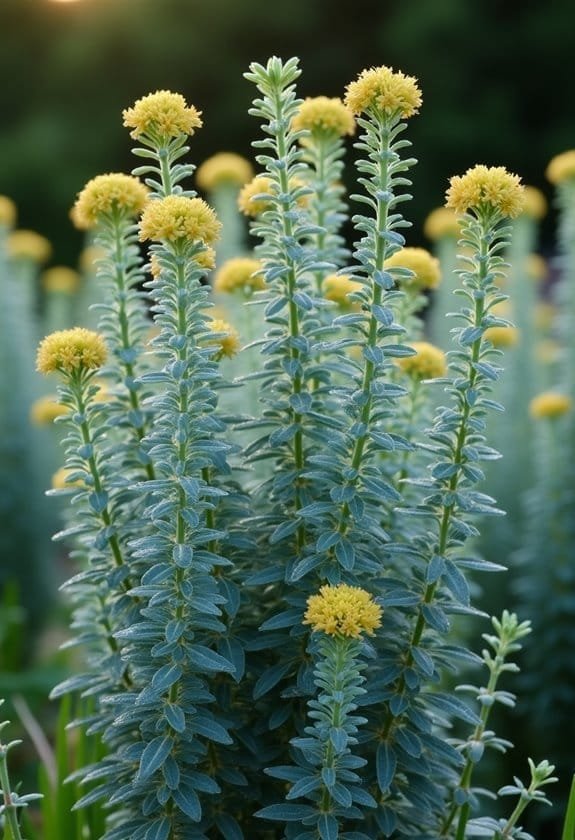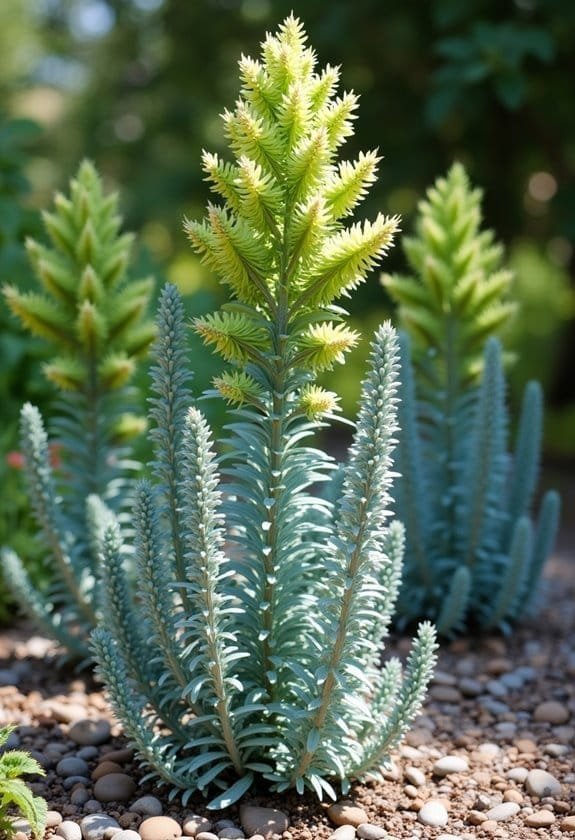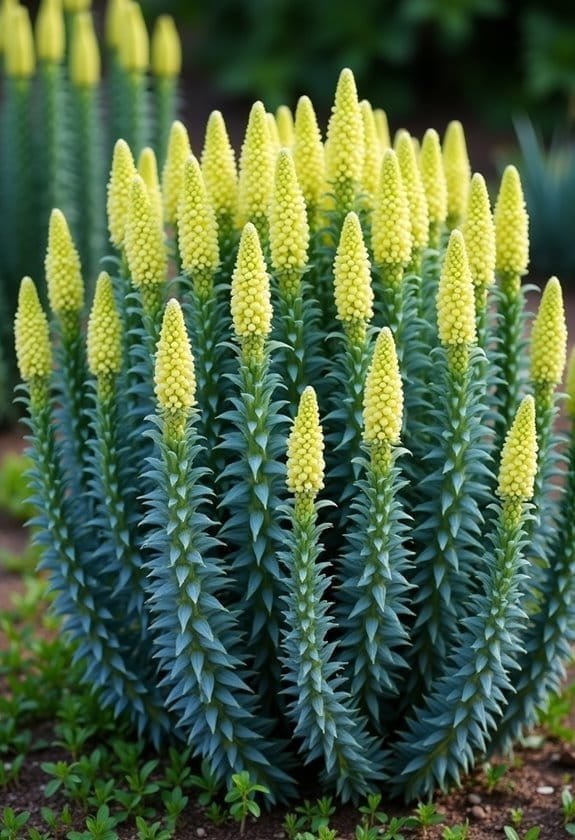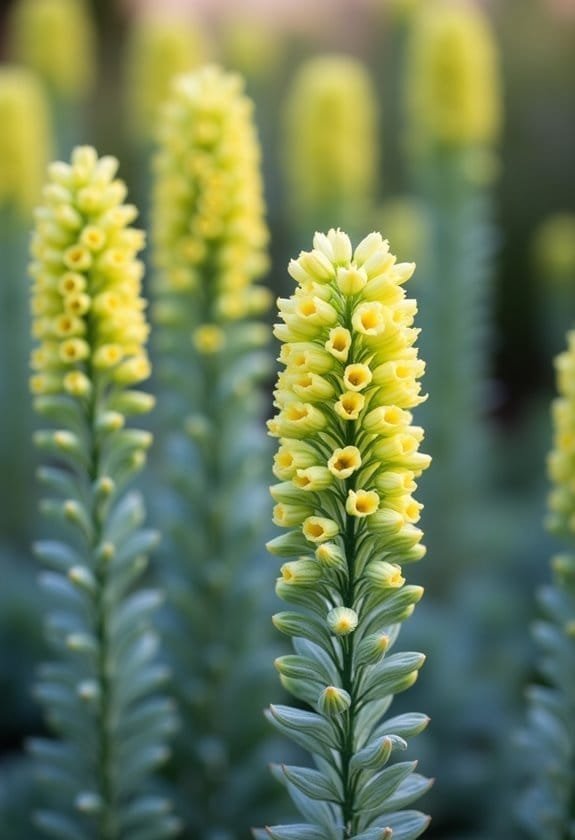Euphorbia characias, known as Mediterranean spurge, is a striking evergreen perennial that reaches heights of 3-4 feet with distinctive blue-green foliage. It produces eye-catching chartreuse flower clusters with purple glands that bloom from early spring through early summer. The plant's architectural form features spirally arranged leaves up to 5 inches long, thriving in full sun and well-drained soils across hardiness zones 6-10. This drought-tolerant beauty proves ideal for low-maintenance Mediterranean gardens, supporting local pollinators while resisting deer and rabbits. Its resilient nature and year-round visual interest make it an excellent choice for those seeking sustainable landscape solutions.
Main Points
- Mediterranean Spurge is an evergreen perennial reaching 3-4 feet tall with distinctive blue-green foliage and chartreuse flower clusters.
- Thrives in hardiness zones 6-10, requiring full sun and well-drained soil, making it perfect for Mediterranean-style gardens.
- The plant blooms from early spring to early summer, featuring yellow-green flowers with purple glands and chartreuse bracts.
- Drought-tolerant and deer-resistant, Mediterranean Spurge is ideal for low-maintenance gardens and xeriscaping projects.
- Contains irritating milky sap requiring protective gloves during handling, but faces few pest and disease problems.
Introduction

Euphorbia characias, commonly known as Mediterranean Spurge, stands as a remarkable evergreen perennial that brings architectural drama to Mediterranean-style gardens and xeric landscapes.
Its distinctive blue-green foliage and chartreuse flower clusters create a striking presence, reaching impressive heights of 3-4 feet in ideal growing conditions.
Native to the sun-drenched regions of the Mediterranean basin, this adaptable plant has earned widespread recognition among gardeners for its drought tolerance and prolonged spring-to-summer flowering period.
Common Name
The Mediterranean Spurge's scientific name, Euphorbia characias, is commonly known for its striking presence in gardens throughout Europe. While many gardeners refer to it simply as Spurge, its full common name reflects its native habitat in the Mediterranean region, where it has flourished for centuries.
The plant's historical nomenclature includes previous classifications as Euphorbia wulfenii and Tithymalus wulfenii, demonstrating the evolving nature of botanical taxonomy.
For those interested in proper pronunciation, the name is articulated as You-FOR-bee-uh kuh-RAY-see-us, though many gardening enthusiasts opt for the more straightforward "Mediterranean Spurge" in casual conversation.
This majestic plant earns its reputation through impressive yellow-green flower clusters that emerge in early spring and persist through early summer, creating a spectacular display in ornamental gardens.
Standing at a commanding height of 3-4 feet, with an equal spread, Mediterranean Spurge commands attention with its statuesque presence and evergreen foliage, making it a distinctive choice for garden designers seeking architectural impact throughout the seasons.
Scientific Name
Moving beyond common names, botanists recognize this Mediterranean beauty by its formal scientific designation, Euphorbia characias subsp. wulfenii. This taxonomic classification places the plant firmly within the extensive Euphorbiaceae family, which encompasses a diverse array of species known for their distinctive floral characteristics and specialized growth patterns.
The scientific nomenclature of Euphorbia characias has undergone several refinements throughout botanical history, with previous classifications including Euphorbia wulfenii and Tithymalus wulfenii. These taxonomic adjustments reflect the ongoing process of botanical research and classification, as scientists work to accurately categorize and understand plant relationships within the Mediterranean flora.
The current subspecies designation, "wulfenii," distinguishes this particular variant from other members of the Euphorbia characias group, highlighting its unique characteristics and evolutionary lineage.
This precise scientific classification helps researchers and horticulturists accurately identify and study the plant's distinctive features, including its impressive 3-4 ft (90-120 cm) height, narrow blue-green foliage, and characteristic yellow-green flower clusters that emerge during the spring flowering period.
Overview
Commanding attention in Mediterranean gardens, Mediterranean Spurge stands as a striking evergreen perennial that combines architectural presence with drought-tolerant resilience. Euphorbia characias rises majestically to heights of 3-4 feet, creating a sculptural silhouette with its dense clusters of blue-green foliage and distinctive yellow-green flower heads.
This adaptable plant showcases its versatility across hardiness zones 6 through 10, thriving particularly in sunny locations where its chartreuse bracts illuminate the landscape from early spring to early summer.
In its natural habitat, Mediterranean Spurge has evolved to flourish in well-drained soils, making it an excellent choice for challenging garden conditions such as rocky slopes and open grasslands.
While its robust nature and resistance to both deer and rabbits make it a practical choice for low-maintenance gardens, gardeners should exercise caution when handling this botanical specimen.
The plant's defensive mechanism includes a milky latex sap that can cause skin irritation upon contact, necessitating careful handling during maintenance activities.
Despite this consideration, Mediterranean Spurge continues to earn its place as a cornerstone of drought-resistant garden design.
Key Features
Mediterranean Spurge stands as a striking evergreen sub-shrub, reaching impressive heights of 3-4 feet with an equal spread, while its narrow blue-green leaves create a spiraling pattern along sturdy stems.
The plant's most distinctive feature emerges in early spring through early summer, when it produces clusters of yellow-green flowers adorned with chartreuse bracts and deep purple nectar glands.
Its architectural form and moderate size make it an excellent choice for both structured gardens and naturalistic landscapes, where its year-round presence adds enduring visual interest.
Growth Size
The stately growth pattern of Euphorbia characias makes it a standout perennial in garden landscapes. When provided with ideal growing conditions, this Mediterranean native develops into a perfectly proportioned specimen, reaching a mature height of 2 to 3 feet (60 to 90 cm) while maintaining a controlled spread of 1.5 to 2 feet (45 to 60 cm).
The plant's architectural form is emphasized by its upright growth habit, which creates a natural sculptural element in garden designs. Along its robust stems, narrow blue-green leaves arrange themselves in an elegant spiral pattern, with individual leaves extending up to 5 inches in length. This foliage arrangement contributes considerably to the plant's overall vertical presence and visual impact.
During its active growing season, Euphorbia characias exhibits impressive vigor, particularly when situated in full sun exposure and well-draining soil conditions.
The plant's natural tendency to grow in a controlled, columnar fashion makes it an excellent choice for both formal gardens and contemporary landscapes, where its distinctive silhouette serves as a strong vertical accent.
Appearance
Striking architectural features define Euphorbia characias, from its spirally arranged blue-green foliage to its distinctive yellow-green flower clusters. This Mediterranean perennial commands attention with its narrow leaves, which stretch up to 5 inches in length and create a mesmerizing spiral pattern around the stems, contributing to its statuesque presence in any garden setting.
The plant's most enchanting characteristic is its floral display, which emerges from early spring through early summer. The chartreuse bracts frame small but intricate flowers, while purple nectar glands add a sophisticated contrast to the overall composition.
Its blue-green foliage maintains year-round interest, as the evergreen nature of this sub-shrub guarantees consistent visual appeal throughout the seasons.
Standing proudly with an upright growth habit, this spurge variety exhibits a naturally sculpted form that requires minimal maintenance to maintain its architectural presence. The plant's drought-tolerant nature complements its ornamental qualities, making it an excellent choice for gardeners seeking both beauty and practicality in well-drained locations.
Flowering Season
Throughout early spring to early summer, Euphorbia characias bursts into bloom, displaying its distinctive yellow-green flower clusters that command attention in any garden setting.
These flowering displays are characterized by their unique chartreuse flowers, which aren't traditional petals at all but rather specialized bracts that create a stunning visual impact.
During the peak blooming period, the plant's dense, spherical to oblong flower clusters become adorned with purple nectar glands, creating a fascinating contrast against the chartreuse bracts.
This combination proves irresistible to various pollinators, including bees, butterflies, and even hummingbirds, which contribute to the garden's biodiversity.
The plant's flowering performance reaches its zenith during these months, transforming landscapes with its architectural presence and vibrant displays.
To maintain the plant's health and encourage robust growth for subsequent seasons, gardeners should remove spent flower stems at their base once blooming concludes.
This practice not only preserves the plant's aesthetic appeal but also channels energy into developing strong new growth for future flowering cycles.
Growing Requirements

Mediterranean Spurge requires abundant sunlight and thrives in well-drained soils, making it an excellent choice for sunny slopes and open gardens.
The plant's remarkable drought tolerance allows it to flourish with minimal watering, though occasional moisture during dry summer months helps maintain its vibrant appearance.
While adaptable to various soil compositions, from sandy to clay-based conditions, this Euphorbia performs best in zones 7-10 and needs protection from harsh winter conditions in cooler regions.
Light
Growing Euphorbia characias successfully requires careful attention to light conditions, as this Mediterranean spurge demands at least 6 hours of direct sunlight daily for optimal growth.
The plant's natural adaptation to bright, sunny environments makes it particularly well-suited for exposed garden locations where many other species might struggle.
As a drought tolerant specimen that thrives in Mediterranean-like conditions, this euphorbia performs best when positioned in full sun settings that mirror its native habitat.
While the plant can tolerate partial shade, such conditions often result in compromised growth patterns, with stems becoming elongated and floppy as they stretch toward available light.
The reduced sun exposure typically leads to diminished flowering performance, affecting the plant's signature chartreuse blooms.
For gardeners seeking to maximize their euphorbia's potential, selecting a planting location that receives abundant sunlight throughout the day is essential.
This sun-loving nature, combined with its ability to establish robust root systems in well-drained soil, makes it an excellent choice for sunny borders, rock gardens, or drought-resistant landscaping schemes.
Soil
Successful cultivation of Euphorbia characias depends critically on proper soil conditions, with well-drained ground being essential for its survival. This Mediterranean native demonstrates remarkable adaptability to various soil compositions, though it shows a particular aversion to waterlogged environments that can compromise its root system's health.
The plant thrives in soil pH levels ranging from 6.0 to 7.5, striking an ideal balance in slightly acidic to neutral growing conditions. While it can flourish in both sandy and clay soils, gardeners should exercise caution with heavy clay compositions, as these dense substrates often retain excessive moisture that can prove detrimental to the plant's development.
For best results, incorporating organic matter or gravel into clay soils can greatly improve drainage capabilities.
Given its drought-tolerant nature, Mediterranean Spurge excels in xeriscaping applications and rocky terrain where water conservation is paramount.
Spring and fall plantings prove most successful, allowing the root system to establish itself thoroughly before facing summer's challenges. This timing, combined with proper soil preparation, guarantees robust growth and long-term sustainability in the garden landscape.
Water
Water management plays an essential role in cultivating Euphorbia characias, striking a delicate balance between drought tolerance and important moisture needs. This Mediterranean native demonstrates remarkable adaptability to dry conditions, making it an excellent choice for water-wise gardens and xeriscaping projects where conservation is paramount.
During the establishment phase, consistent watering in sunny, well-drained locations helps develop a robust root system that will sustain the plant through future dry spells. While Mediterranean Spurge appreciates occasional moisture during arid summers, it's important to avoid overwatering, which can lead to detrimental root rot and compromise the plant's overall health.
Once established, this drought-tolerant perennial requires minimal irrigation, reflecting its natural adaptation to Mediterranean climate patterns. The plant's successful cultivation hinges on providing adequate moisture during extended dry periods while ensuring proper drainage prevents water accumulation around the roots.
Full sun exposure further enhances the plant's ability to manage moisture effectively, reducing the risk of fungal diseases that often develop in overly humid conditions.
Temperature
Throughout Mediterranean regions, Euphorbia characias demonstrates remarkable resilience to temperature fluctuations, particularly thriving in USDA hardiness zones 7 to 10. This drought-tolerant perennial adapts seamlessly to its native climate, where warm days and cool nights create ideal growing conditions for its distinctive architectural form.
The plant's cold hardiness is quite impressive, as it withstands winter temperatures dropping to -15°C (5°F) without significant damage to its structural integrity. However, while this Mediterranean native shows admirable tolerance for cold conditions, it exhibits a notable aversion to hot, humid environments that can compromise its health and vigor.
The plant's temperature preferences reflect its evolutionary adaptation to Mediterranean climates, where summers are typically warm and dry rather than humid and oppressive. During peak growing seasons, maintaining appropriate temperature conditions becomes vital for optimal development, especially when the plant is establishing its characteristic flowering stems.
Gardeners in regions with compatible climate patterns can expect robust growth and prolific blooming, provided they offer full sun exposure and protect the plant from excessive humidity.
Pollinator Criteria
Mediterranean Spurge plays an essential role in supporting pollinator populations through its distinctive floral structure and abundant nectar production.
The plant's chartreuse flowers and bright lime-yellow bracts create an irresistible beacon for bees, butterflies, and hummingbirds during its flowering period from early spring to early summer.
Its specialized cup-like cyathia, equipped with dark or yellow nectar glands, provide efficient access points for these beneficial insects and birds, making it an excellent choice for biodiversity-focused gardens.
Attracted Pollinators
Serving as an essential food source for diverse pollinators, Euphorbia characias subsp. wulfenii attracts bees, butterflies, and hummingbirds with its abundant nectar and pollen-rich flowers. During its peak blooming period from early spring through early summer, this Mediterranean native creates a vibrant feeding station for these vital ecosystem participants.
The plant's distinctive chartreuse flower bracts and deep purple nectar glands serve as natural beacons, drawing pollinators like moths to a flame. These visual cues, combined with the plant's copious nectar production, make it particularly effective at supporting local pollinator populations throughout its extended flowering season.
Its drought-tolerant nature allows it to maintain consistent nectar production even in water-stressed conditions, making it an invaluable resource in xeriscaped gardens. By incorporating Mediterranean Spurge into planned landscapes, gardeners contribute markedly to local biodiversity and ecosystem health.
The plant's reliable presence helps establish sustainable pollinator corridors, creating interconnected habitats that support these essential creatures throughout the growing season.
Pollination Method
How does Euphorbia characias achieve successful pollination? The flowering plant employs a sophisticated combination of visual and nutritional attractions to guarantee effective reproduction. Its distinctive chartreuse bracts and purple nectar glands create an irresistible beacon for diverse pollinators during the critical spring-to-summer period.
The plant's specialized cyathia structure serves as both an advertisement and a practical landing platform for visiting insects and birds. These cup-shaped formations, positioned prominently within the flower clusters, provide easy access to abundant nectar reserves, encouraging thorough pollinator visitation.
The timing of Mediterranean Spurge's blooming cycle strategically aligns with peak pollinator activity, maximizing the chances of successful fertilization.
During drought conditions, when other plants may struggle to produce flowers, Euphorbia characias maintains its role as a reliable nectar source. This adaptability guarantees consistent pollination opportunities throughout its flowering season, while simultaneously supporting local pollinator populations.
The plant's efficient pollination mechanism, combined with its drought tolerance, creates a mutually beneficial relationship that strengthens both species survival and ecosystem stability.
Care & Maintenance

Euphorbia characias thrives with minimal intervention once it's established in well-draining soil, requiring only occasional watering during dry spells and a spring pruning of spent flower stems.
The plant's maintenance routine includes protective gloves for all handling tasks, as its milky sap can cause skin irritation and other toxic reactions.
While fertilization isn't essential, gardeners can boost the plant's vigor with a balanced fertilizer in early spring, and it pairs beautifully with drought-tolerant companions like lavender and ornamental grasses.
Planting Tips
Three key factors guarantee successful growth of Mediterranean Spurge: full sun exposure, well-drained soil, and proper timing of planting. Euphorbia characias thrives in locations that mirror its native Mediterranean landscape, where rocky or sandy soils provide excellent drainage and abundant sunlight nurtures its distinctive chartreuse blooms.
For ideal establishment, gardeners should plant Mediterranean Spurge during spring or fall, allowing the root system to develop before facing seasonal extremes.
When selecting a planting site, verify the soil drains efficiently, as waterlogged conditions can lead to devastating root rot. While this architectural plant tolerates drought once established, consistent moisture during the initial growing period helps develop robust root systems.
Space plants approximately 24 inches apart to accommodate their mature spread, and consider incorporating gravel or sand into heavy soils to improve drainage.
In Mediterranean landscaping schemes, these plants serve as striking focal points when grouped in odd numbers or positioned along sunny borders.
After planting, apply a light layer of mulch to retain moisture while keeping the crown slightly exposed to prevent decay.
Ongoing Care
Properly established Mediterranean Spurge demands minimal ongoing care, making it an ideal choice for low-maintenance gardens. The plant thrives independently in well-drained soils, requiring supplemental watering only during extended dry periods to maintain its vigorous growth.
Post-flowering maintenance focuses primarily on strategic pruning to enhance the plant's aesthetic appeal and promote healthy development. After the blooms fade, gardeners should remove spent flower stems at their base, which stimulates fresh growth and helps maintain the plant's distinctive architectural form.
While pruning, it's crucial to wear protective gloves, as the plant's milky sap contains irritating compounds that can cause skin and eye discomfort.
Although Mediterranean Spurge typically doesn't require fertilization as part of its ongoing care routine, applying a balanced fertilizer can boost its performance in less-than-ideal conditions.
Regular monitoring for unwanted seedlings is recommended, as these volunteers can be removed through selective pruning to maintain the desired garden composition. This minimal maintenance approach allows gardeners to enjoy the plant's striking appearance without investing significant time in its upkeep.
Suggested Companions
Selecting appropriate companion plants enhances both the visual appeal and overall health of Mediterranean Spurge gardens. The striking blue-green foliage of this Euphorbia species creates a dramatic backdrop for complementary perennials, particularly in rock gardens where textural contrast becomes paramount.
Drought-tolerant plants like lavender and salvia make ideal companions, as they share Mediterranean Spurge's preference for full sun exposure and well-drained soil conditions. The integration of low-growing groundcovers, such as creeping thyme or sedum, serves multiple purposes by suppressing weed growth and maintaining soil moisture levels around the plant's base.
Ornamental grasses, particularly blue fescue and feather reed grass, introduce dynamic movement and textural diversity to the garden composition.
When planning companion plantings, it's crucial to reflect on the water and soil requirements of each species. Gaillardia and echinacea prove particularly successful partners, as their vibrant blooms complement the architectural presence of Mediterranean Spurge while thriving under similar growing conditions.
This thoughtful combination of plants creates a sustainable and visually cohesive garden environment that celebrates Mediterranean flora's natural beauty.
Common Issues
Mediterranean Spurge faces relatively few pest and disease challenges, though it can occasionally attract aphids, mealybugs, and scale insects that feed on its succulent stems and foliage.
Regular inspection of the plant's leaves and stems helps gardeners identify these unwanted visitors early, making control measures more effective through targeted insecticidal soap applications.
While these pests rarely cause fatal damage to the plant's robust structure, prompt treatment prevents the spread of infestations and maintains the plant's characteristic architectural form.
Pests/Diseases
Despite its hardy nature, Euphorbia characias faces a limited number of potential health issues. The plant's remarkable resilience comes from its natural defense mechanisms, particularly its milky latex sap, which effectively deters common garden pests like deer and rabbits from causing damage to the foliage.
While Mediterranean Spurge generally maintains robust health, there are specific conditions that can compromise its well-being. Root rot poses a significant threat when the plant is situated in poorly draining soils, making proper soil preparation and drainage essential for long-term health.
In environments with high humidity, powdery mildew may develop on the foliage, necessitating adequate spacing between plants to promote air circulation and reduce fungal growth.
Although generally pest-resistant, aphids occasionally attempt to colonize Euphorbia characias, particularly during periods of stress or environmental change. These small insects can typically be managed effectively through the application of horticultural soap or targeted insecticidal treatments, ensuring the plant maintains its ornamental appeal without requiring extensive intervention.
Solutions
To address common issues affecting Euphorbia characias, gardeners can implement several practical solutions that guarantee the plant's health and vigor.
Managing water balance proves vital, as this Mediterranean native requires strategic irrigation during extended dry periods while avoiding waterlogged conditions.
For ideal drainage, incorporating coarse sand or gravel into the planting site helps prevent root rot, which can devastate the plant's root system.
The characteristic white milky sap requires careful handling, so gardeners should always wear thick protective gloves during maintenance to prevent skin irritation.
To control aggressive self-seeding, regular monitoring and prompt removal of unwanted seedlings maintain the desired garden composition and prevent overcrowding.
Post-flowering maintenance demands precise pruning techniques, with spent flower stems cut cleanly at their base to promote robust new growth and maintain the plant's architectural form.
Installing physical barriers around garden beds can help contain spreading, while applying a thick layer of mulch suppresses unwanted seedlings and helps retain essential soil moisture during drought conditions.
Summary

This striking evergreen perennial, Euphorbia characias subsp. wulfenii, stands out in gardens with its blue-green foliage and vibrant yellow-green flower clusters that bloom from early spring to early summer.
Also known as Mediterranean Spurge, this robust plant reaches impressive heights of 3-4 feet, creating a commanding presence in dry gardens and rocky landscapes.
The plant's adaptability to challenging conditions makes it an exceptional choice for low-maintenance gardens in USDA zones 7-10, where it thrives with minimal intervention once established.
While it requires occasional watering during dry spells, its drought-tolerant nature guarantees sustained performance in water-conscious landscapes.
Its chartreuse blooms serve as beacons for pollinators, enhancing garden biodiversity, while its natural resistance to deer and rabbits adds to its practical appeal.
However, gardeners should exercise caution when handling Euphorbia characias, as its milky latex sap can cause skin irritation and digestive issues if ingested.
With proper precautions, this architectural plant offers a perfect blend of aesthetic appeal and practical benefits for modern garden designs.


